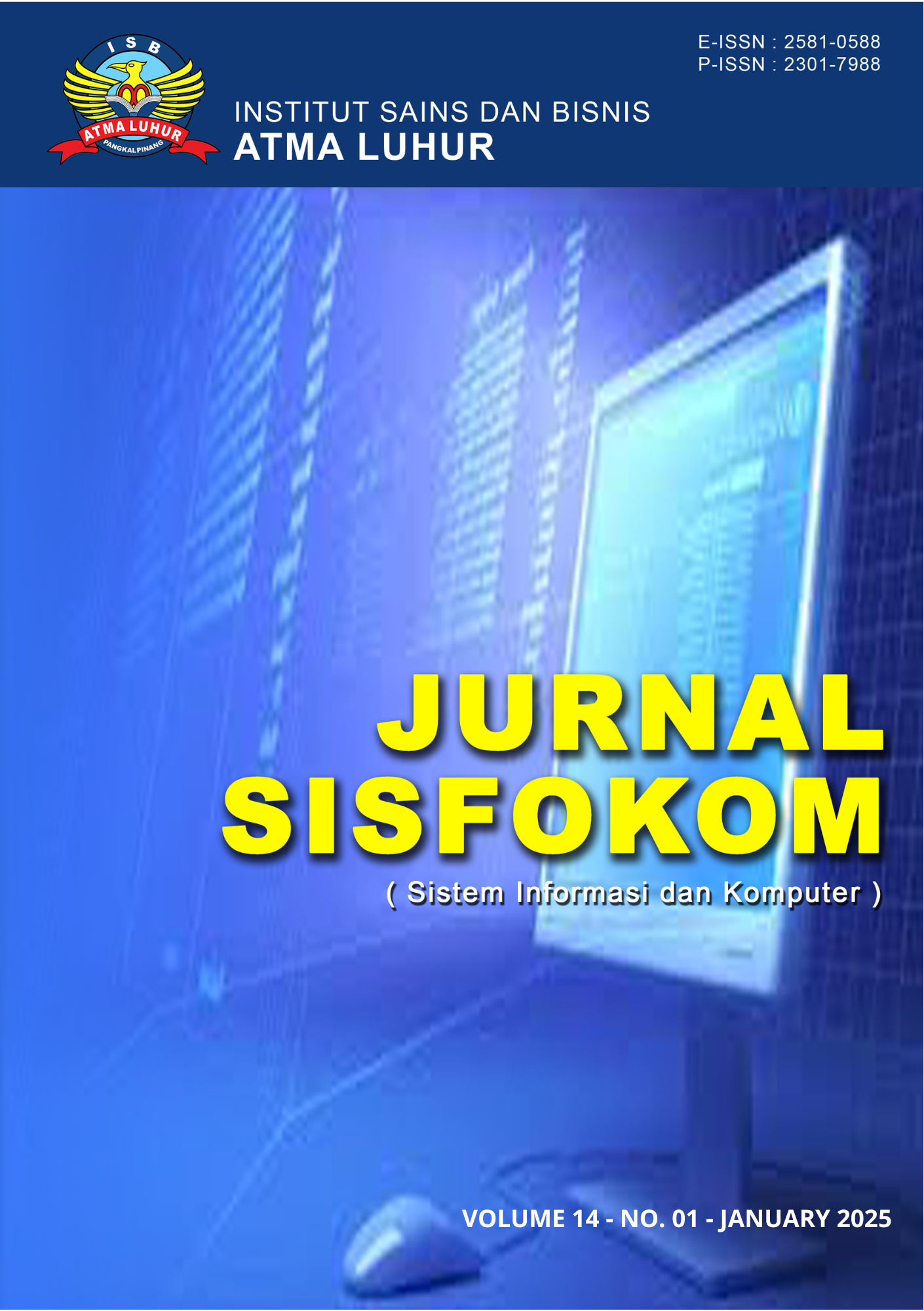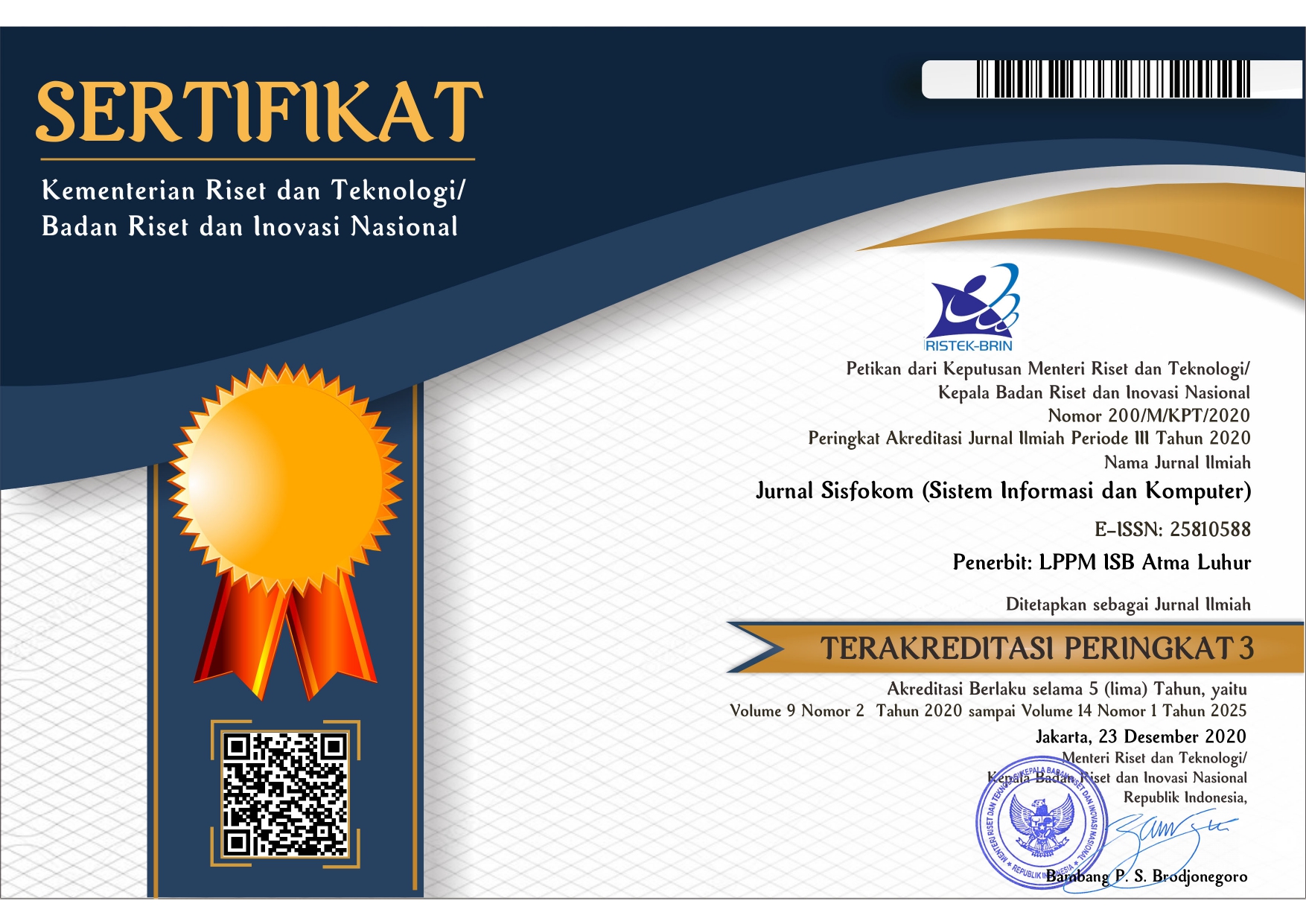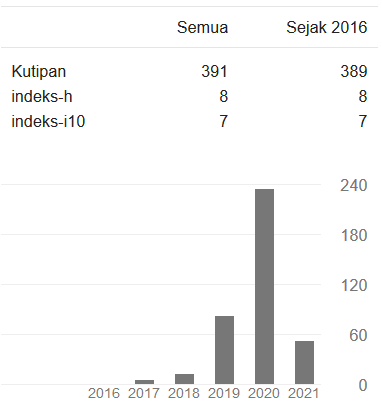Feature Extraction using Histogram of Oriented Gradients and Moments with Random Forest Classification for Batik Pattern Detection
DOI:
https://doi.org/10.32736/sisfokom.v14i1.2225Keywords:
Classification, Batik, Histogram of Oriented Gradients, Texture Moments, Random ForestAbstract
The preservation of traditional batik patterns, often transmitted orally and through direct practice across generations, faces significant challenges in the modern era. Globalization introduces the risk of cultural homogenization, potentially diminishing the uniqueness and diversity of these patterns. Furthermore, the manual recognition of batik motifs is labor- intensive, time-consuming, and requires specialized expertise, rendering it unsuitable for large-scale preservation initiatives. Consequently, the development of technology-based solutions capable of documenting, analyzing, and recognizing batik patterns with efficiency and precision is imperative for safeguarding this cultural heritage. This study aims to address these challenges by developing an automated system for recognizing batik patterns, focusing on Javanese batik motifs—Kawung, Megamendung, and Parang—which serve as foundational designs for the evolution of batik in other regions. The proposed methodology integrates two feature extraction techniques, Histogram of Oriented Gradients (HOG) and Texture Moments, with the Random Forest machine learning algorithm. The research process encompasses four key stages: pre-processing, feature extraction, classification, and system evaluation, where the accuracy of individual and combined feature extraction methods is analyzed. Experimental results reveal that the HOG method achieves an accuracy of 78.99%, while the Texture Moments method yields 81.88%. Notably, the combination of these two methods enhances system performance, achieving the highest accuracy of 86.23%, representing a 4.65% improvement over the single methods. These findings underscore the efficacy of integrating HOG and Texture Moments with the Random Forest algorithm for automated batik pattern recognition.References
S. Akbar, R. A. Fahreza, F. Ferdianto, D. F. Wulandari, and E. W. Astuti, "Klasifikasi Pes Planus Menggunakan Ekstraksi Fitur HOG dan BoF dengan Random Forest," Journal Of Electronics And Instrumentation, vol. 1, no. 1, pp. 1-10, 2024.
S. D. Amanda, A. K. Ramadina, and S. P. Wulandari, "ANALISIS FAKTOR-FAKTOR KUALITAS PENDIDIKAN DI INDONESIA TAHUN 2023 MENGGUNAKAN ANALISIS FAKTOR," SINDORO CENDEKIA PENDIDIKAN, vol. 2, no. 1, pp. 50-60, 2023.
T. H. Andika and N. S. Anisa, "Sistem Identifikasi Citra Daun Berbasis Segmentasi Dengan Menggunakan Metode K-Means Clustering," Aisyah Journal of Informatics and Electrical Engineering, vol. 5, no. 2, pp. 33- 45, 2020.
S. P. Bagu, N. A. Tanumihardja, and Michelle, "VISUALISASI BATIK PARANG YOGYAKARTA," Jurnal Penelitian Multidisiplin, vol. 9, no. 1, pp. 21-35, 2024.
S. P. Bagu, N. A. Tanumihardja, and Michelle, "VISUALISASI BATIK PARANG YOGYAKARTA," BEGIBUNG: Jurnal Penelitian Multidisiplin, vol. 9, no. 1, pp. 21-35, 2024.
K. R. Giri, W. Y. Putra, G. A. Utami, N. W. Utami, and D. G. Putra, "IDENTIFIKASI ARSITEKTUR KOLONIAL DALAM POLA TRANSFORMATIF REGIONALISME PADA RUMAH MAKAN DAPOER PEMUDA DI DENPASAR," Prosiding Seminar Nasional Manajemen, Desain & Aplikasi Bisnis Teknologi (SENADA), vol. 2, no. 1, pp. 102-115, 2024.
R. Handoko, D. Ramadhansyah, A. Asrofiq, A. Rahmaddeni, and Y. Yunefri, "ANALISIS SENTIMEN ULASAN PENUMPANG MASKAPAI PENERBANGAN DI INDONESIA DENGAN ALGORITMA RANDOM FOREST DAN KNN," Jurnal Sistem
Informasi, vol. 10, no. 1, pp. 24-38, 2024.
G. S. Hussein, S. Elseuofi, W. H. Dukhan, and A. H. Ali, "A Novel Method for Banknote Recognition Using a Combined Histogram of Oriented Gradients and Scale-Invariant Feature Transform," Information Sciences Letters, vol. 8, no. 4, pp. 200-215, 2023.
I. Barkiah and A. Y. Ida, "Overcoming Overfitting Challenges with HOG Feature Extraction and XGBoost-Based Classification for Concrete Crack Monitoring," INTL JOURNAL OF ELECTRONICS AND TELECOMMUNICATIONS, vol. 7, no. 3, pp. 110-125, 2023.
A. Ikram, N. Mutmainna, J. Khasmawati, D. Wahyuli, I. W. Sudarsana, et al., "TRANFORMASI CALANTHE TRIPLICATA UNTUK BRANDING UNIK MOTIF BATIK SULAWESI TENGAH," Jurnal Ilmiah Matematika dan Terapan, vol. 6, no. 2, pp. 55-68, 2022.
T. L. Kaunang, J. J. Tinangon, and V. Z. Tirayoh, "ANALISIS PENERAPAN SISTEM PENGENDALIAN MANAJEMEN UNTUK MENINGKATKAN KINERJA PERUSAHAAN PADA PT. PERUSAHAAN LISTRIK NEGARA (PERSERO) UNIT LAYANAN PELANGGAN MANADO SELATAN," Jurnal EMBA, vol. 8, no. 3, pp. 77-90, 2021.
A. Khadafi and M. Iqbal, "Implementation of Random Forest for Motif Classification Based on Sift," Jurnal Mantik, vol. 5, no. 4, pp. 149-162, 2022.
M. Muchtar and R. A. Muchtar, "Ekstraksi Fitur LBP Dan Moment Invariant Untuk Identifikasi Jenis Kayu Menggunakan SVM," INTEGRASI FITUR WARNA, TEKSTUR DAN RENYI FRAKTAL UNTUK KLASIFIKASI PENYAKIT DAUN KENTANG MENGGUNAKAN LINEAR DISCRIMINANT ANALYSIS, vol. 2, no. 2, pp. 140-150, 2024.
N. Larasati, S. Devella, and M. E. Rivan, "Pengenalan ASL Menggunakan Metode Ekstraksi HOG Dan Klasifikasi Random Forest," Jurnal Teknik Informatika dan Sistem Informasi, vol. 7, no. 1, pp. 45-58, 2021.
M. Meiriyamaa and Sudiadia, "Penerapan Algoritma Random Forest Untuk Klasifikasi Jenis Daun Herbal," JTSI, vol. 9, no. 2, pp. 22-35, 2022.
N. M. Mitayani and D. A. Astuti, "PENGEMBANGAN BATIK KHAS KEBUDAYAAN INDONESIA DENGAN PENGARUH TEKNOLOGI," e-journal unmas, vol. 6, no. 3, pp. 110-125, 2024.
A. Gumilang dan S. Agustin, "Deteksi Kepribadian Melalui Margin Pada Tulisan Tangan Menggunakan Random Forest," Jurnal Inovtek Polbeng - Seri Informatika, vol. 9, no. 1, pp. 311-325, 2024.
S. Agustin, A. Sari, dan Ernawati, "Pengenalan Huruf Braille menggunakan Radially Average Power Spectrum dan Geometri," Jurnal Inovtek Polbeng - Seri Informatika, vol. 8, no. 1, pp. 25-35, 2023.
Downloads
Published
Issue
Section
License
Copyright (c) 2025 Jurnal Sisfokom (Sistem Informasi dan Komputer)

This work is licensed under a Creative Commons Attribution 4.0 International License.
The copyright of the article that accepted for publication shall be assigned to Jurnal Sisfokom (Sistem Informasi dan Komputer) and LPPM ISB Atma Luhur as the publisher of the journal. Copyright includes the right to reproduce and deliver the article in all form and media, including reprints, photographs, microfilms, and any other similar reproductions, as well as translations.
Jurnal Sisfokom (Sistem Informasi dan Komputer), LPPM ISB Atma Luhur, and the Editors make every effort to ensure that no wrong or misleading data, opinions or statements be published in the journal. In any way, the contents of the articles and advertisements published in Jurnal Sisfokom (Sistem Informasi dan Komputer) are the sole and exclusive responsibility of their respective authors.
Jurnal Sisfokom (Sistem Informasi dan Komputer) has full publishing rights to the published articles. Authors are allowed to distribute articles that have been published by sharing the link or DOI of the article. Authors are allowed to use their articles for legal purposes deemed necessary without the written permission of the journal with the initial publication notification from the Jurnal Sisfokom (Sistem Informasi dan Komputer).
The Copyright Transfer Form can be downloaded [Copyright Transfer Form Jurnal Sisfokom (Sistem Informasi dan Komputer).
This agreement is to be signed by at least one of the authors who have obtained the assent of the co-author(s). After submission of this agreement signed by the corresponding author, changes of authorship or in the order of the authors listed will not be accepted. The copyright form should be signed originally, and send it to the Editorial in the form of scanned document to sisfokom@atmaluhur.ac.id.









